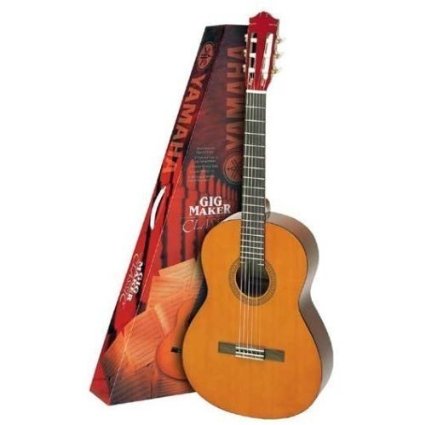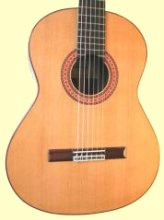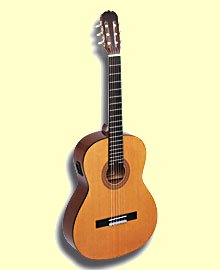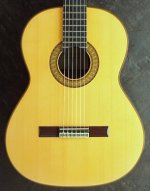History Of The Classical Guitar
My intention was to write my own version of the history of the classical guitar, but I decided against it. There are so many pages on the internet with a history that I thought it best to simply seek out the best ones and link to them from here.
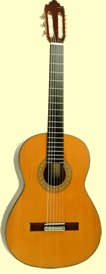
Thomas F. Heck
Thomas F. Heck's 1972 paper, "Stalking the Oldest Six-String Guitar" can be found on the website of the Guitar Foundation of America. This is a history of the classical guitar worth reading.
A single cardboard box of photocopies of rare guitar music was the beginning of the Foundation's archive. The GFA's founding archivist, Thomas Heck, had spent a year collecting first editions of Guiliani's music in Vienna in the late 1960's.
In 1973 the GMA was born and the archive is now housed in the Bierce Library at the University of Akron. The current archivist is Nancy L. Stokes.
Read more about the archive, its history and its collection here.
History Of The Spanish and Classical Guitar
The Spanish Guitar Emerges:
With the coming of the Renaissance, inspired in part by Moslem learning brought home by returning Crusaders, the lute become the favorite instrument of Western Europe.
In Spain however, the lute was already overshadowed by a new instrument, the guitar. Two types of guitar were played by the Pyrenees: the vihuela, in the court and among fashionable society, and the guitarra latina, by ordinary folk. The former had eleven strings, five double and one single, and was plucked. The latter had four double strings and was strummed. The vogue of the vihuela reached a peak in the first half of the sixteenth century when many composers wrote works for it. At about the same time a fifth string was added to the guitarra latina, which thereupon gained so rapidly in public favour that by the end of the century it had displaced its rival throughout most of the lberian Peninsula.
During the seventeenth century, as lute-playing declined in popularity, guitars began to find their way abroad to France, Germany and Italy, where the instruments were referred to as "Spanish Guitars". The instrument was played at the sumptuous court of France's Louis XIV and the Sun King himself took lessons on it. By the middle of the 18th century the guitar was firmly established in fashionable circles throughout Contintinental Europe. Thereafter, its voice was increasingly drowned out by those louder and more 'sophisticated' stringed instruments - the harpsichord, piano and violin.
But the guitar was soon to make a comeback. Towards the end of the century a sixth string, the low E string was added - most likely in the instance by a certain music-master from Dresden named Naumann. Before long, the sixth-string guitar was standard throughout Europe. At about this time, moreover,there came to the fore in Spain guitarists unprecedented virtuosity and flair, among whom the most noteworthy was Fredinand Sor (1778 -1839). Sor, not only a gifted performer and showman, but also a diligent composer and transcriber of works for the guitar, toured the continent and finally England where his impact on the musical community was tremendous. Thanks to the missionary work of Sor and other talented Spanish guitarists, the guitar regained its popularity and world-famous composers, accepting it for the first time as a usable instrument, began to write music expressly for it. Rossini did so in his score for "The Barber of Seville" and "Verdi in Otello", while Schubert, Haydn and to an ever greater extent Paganini and Berlioz, all composed guitar music.
Enter The Concert (or Classical) Guitar:
Until about 150 years ago guitars were normally played solo, with or without accompanying voices to relatively small audiences.
Once it became a concert instrument, guitarists were called upon to perform in larger halls, often together with musicians playing other instruments. it soon became obvious that the six stringed instrument needed much more volume if it was to make itself heard in these altered conditions. this led to increases in size and hence, in volume - which eventually resulted in the concert guitar we know today.
Not surprisingly, the two men most responsible for the concert guitar were both Spaniards - Torres (1817-1899) and Tarrega (1852 -1909), Torres, working in collaboration with the guitarist Juilian Arcos, increased the size of the instrument, particularly by making the two bouts of the soundbox wider in relation to its overall length. he also increased the scale length (the distance between the bridge saddle and the nut, where the sting vibrate freely), which ultimately came to be standardized at 26 inches. Torres improved the fingerboard by flattening it and reducing its width to about two inches, thereby making fingering an easier matter than it had been before. Perhaps mast importantly of all, he redesigned the entire internal structure of the soundbox giving it seven fan braces instead of three - placing extra braces at the tail around the sound hole, and on the ribs. this not only strengthened the instrument, but also improved its tone and raised its volume by distributing vibrations evenly to every part of the body below the sound hole. Subsequently, other guitar-makers further refined the instrument, but Torres' contributions remain the most fundamental of any.
If Torres pioneered the design of the concert guitar, Tarrega pioneered the playing techniques used by concert guitarists. His innovations, collectively known as the ‘Tarrega method', cover such matters as proper positioning of the guitar on the player's left knee, the correct placing of his/her hands, procedures for plucking the strings and mast particularly, the effect use of the right hand.
Since Tarrega, a number of outstanding concert guitarists have entranced audiences throughout the world, including two of the master's pupils, Llobet and Pujol. Today there are many great concert artists who give regular guitar recitals in major cities around the world, each one is to some degree, a product of the line of development set in motion by Andres Segovia - the first concert guitarist to confront and conquer the mass media. Via the medium of radio and records, plus his concert performances and teaching, Segovia established the playing patterns, repertoire and attitudes that have prevailed throughout the Western world for more than 50 years. Several great guitarists - Julian Bream, John Williams and Leo Brouer, to name but three, have contributed to the expansion of the Segovian repertoire, but despite their efforts, the run-of-the-mill classical guitarist still draws from the well that Segovia dug.
Mike Hayes is a guitar teacher, author, performing musician and session guitarist with over 30 years of professional experience. Mike's methods are legendary and have earned the praise of top authorities in guitar instruction. Click on this link for Mike's free beginner guitar lessons and tips at
GuitarCoaching.com Article Source: EzineArticles.com/?expert=Mike_Hayes
Other Interesting Links
More in depth history can be found at the following link classical guitar illustrated history
The classical guitar section of Will Kalif's web site, Storm The Castle, is well worth a visit. Follow the link below.
The classical guitarist - Advice, Tips, tutorials, and insightful essays about the world of classical guitar.
As I research more useful articles I'll add links to them here, so keep calling back. Meanwhile if you find anything of interest please let me know by completing the following form.
Return to Top: History of the Classical Guitar
Lost? Search Our Site!
Classical Guitars --- Spanish Guitar Makers --- Other Guitar Makers
Classical Guitar Players --- History of Classical Guitar --- Learn to Play Classical Guitar
Build Classical Guitars --- Guitar Making Schools --- Privacy Policy
Used Classical Guitars for Sale --- History of Classical Guitar




